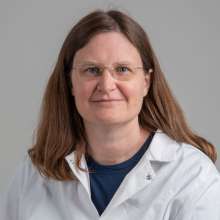Bettina Willie
- Associate Dean of Research and Graduate Education (2023-2025)
- Associate Member, Department of Biomedical Engineering and Department of Pediatric Surgery
***Note: Dr. Willie is not recruiting any new students. ***

Bettina Willie earned a doctoral degree in Bioengineering from the University of Utah and underwent postdoctoral training at the Institute for Trauma Surgery and Biomechanics, University of Ulm in Ulm, Germany and then at the Hospital for Special Surgery, Weill Cornell Medical College in NYC, USA. From 2008-2015, she led a research group in the Julius Wolff Institute at the Charité - Universitätsmedizin Berlin, in Germany. She became an Associate Professor in 2015 and a Full Professor in 2022 in the Department of Pediatric Surgery, Faculty of Medicine and Health Sciences at McGill University. In mid-2022, she joined the Faculty of Dental Medicine and Oral Health Sciences as a Tenured Full Professor. Since 2015, she has been an investigator at Shriners Hospitals for Children-Canada and an Associate Member in the Departments of Biomedical Engineering, Surgery, and Pediatric Surgery at McGill University.
Her research program uses computational and experimental approaches, including state-of-the-art high resolution imaging technologies, to study the causes and improve the detection and treatment of skeletal fragility and craniofacial abnormalities, especially in rare diseases. She is particularly interested in understanding mechanisms of bone adaptation and regeneration to mechanical stimuli to develop strategies to inhibit bone loss and enhance healing. She examines the role of osteoblastic cells (osteocytes and osteoblasts) in the mechanosensation processes, since these cells make up the primary sensor and effector cells of mechanical cues.
The following themes comprise her research program:
Theme 1: Determine the causes and improve detection & treatment of skeletal fragility and craniofacial abnormalities in rare bone diseases (eg. osteogenesis imperfecta, XLH, multiple myeloma bone disease, marfan syndrome, gerodermia osteodysplastica).
Theme 2: Determine the mechanistic role that the circadian clock plays in mechanoadaptive bone (re)modeling.
Theme 3: Enhance bone healing and osseointegration using novel drugs and biophysical therapies.
Theme 4: Investigate mechanical stimuli as an adjuvant bone anabolic therapy in rare bone diseases
Theme 5: Examine how skeletal aging and the mechanical environment affect bone fragility in egg laying hens.
***Note: Dr. Willie is not recruiting any new students. ***
PhD, Bioengineering, University of Utah
Skeletal Mechanobiology, Osteocytes, Bone healing, Bone adaptation, Rare bone diseases, Microcomputed tomography, Circadian rhythms in bone
Gabel L, Kent K, Hosseinitabatabaei S, Burghardt AJ, Leonard MB, Rauch F, Willie BM, Guidelines on high-resolution peripheral quantitative computed tomography assessment of bone density, microarchitecture, and strength in pediatric populations, Current Osteoporosis Reports, 21(5):609-623, 2023.
Vitienes I, Mikolajewicz N, Hosseinitabatabaei S, Bouchard A, Julien C, Graceffa G, Rentsch A, Widowski TM, Main R, Willie BM, Breed and loading history influence in vivo skeletal strain patterns in female chickens, Bone, 173:116785, 2023.
Hosseinitabatabaei S, Mikolajewicz N, Zimmermann EA, Rummler M, Steyn B, Julien C, Rauch F, Willie BM, 3D image registration marginally improves the precision of HR-pQCT measurements compared to cross-sectional-area registration in adults with osteogenesis imperfecta, Journal of Bone and Mineral Research, 37(5):908-924, 2022.
Bouchard A, Dsouza C, Julien C, Rummler M, Gaumond M-H, Cermakian N, Willie BM, Bone adaptation to mechanical loading in mice is affected by circadian rhythms, Bone, 24:116218, 2021.
Mikolajewicz N, Zimmerman EA, Rummler M, Hosseinitabatabaei S, Julien C, Glorieux F, Rauch F, Willie BM, Multisite longitudinal calibration of HR-pQCT scanners and precision in osteogenesis imperfecta, Bone, 147:115880, 2021
Rummler M, Ziouti F, Bouchard A, Brandl A, Duda GN, Bogen B, Beilhack A, Lynch M, Jundt F, Willie BM, Mechanical stimulation rescues bone loss and exerts cell-extrinsic anti-tumor effects in the MOPC315.BM.Luc model of myeloma bone disease, Acta Biomaterialia, 119:247-258, 2021.